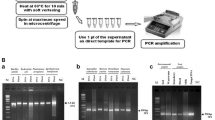Summary
The present report describes a novel approach for the identification of human or non-human specimens after long-term storage in a badly preserved state. The application of the PCR-technique (polymerase chain reaction) using human-specific primers as well as Southern blot (filter) hybridization of the sample DNA to a primate-specific DNA probe enabled us to extend the positive identification beyond the limits of conventional methods such as serological or morphological examinations.
Zusammenfassung
Der vorliegende Bericht beschreibt eine neuartige Strategie für die Identifizierung von menschlichen oder nicht-menschlichen Geweben nach Langzeitlagerung in schlecht erhaltenem Zustand. Die Anwendung der PCR-Technik (Polymerase Kettenreaktion) mit Hilfe humanspezifischer Starter sowie mit Hilfe der Southern Blot-Hybridisierung der Proben-DNA mit einer Primaten-spezifischen DNA-Sonde versetzte uns in die Lage, die positive Identifizierung jenseits der Nachweisgrenzen konventioneller Methoden, wie serologische und morphologische Untersuchungen auszudehnen.
Similar content being viewed by others
References
Rapidophor Electronic Manual (1980). Immuno AG, Vienna
Pflug W (1981) Subtyping of group specific component (GC) in micro-bloodstains and semen stains by isoelectric focusing inultrathin immobilized pH gradient gels followed by enzyme immunodetection. Electrophoresis 9:443–448
Cotter FE, Hampton GM, Nasipuri S, Bodmer WF, Young BD (1990) Rapid isolation of human specific DNA probes from a somatic cell hybrid. Genomics 7:257–263
Müllenbach R, Lagoda PJL, Welter C (1989) An efficient saltchloroform extraction of DNA from blood and tissues. Trends Genet 5:391
Sambrook J, Fritsch EF, Maniatis T (1989) Molecular Cloning, 2nd edn. Cold Spring Harbor Laboratory Press
Metzdorf R, Göttert E, Blin N (1988) A novel repetitive DNA from human chromosome 22. Chromosoma 97:154–158
Scherthan H, Lutz S, Metzdorf R, Blin N (1989) Interspecies relationship of a repetitive chromosome-specific DNA. Hereditas 111:183–188
Rigby PWJ, Diekmann M, Rhodes C, Berg P (1977) Labeling deoxyribonucleic acid to high specifity in vitro by nick translation with DNA polymerase 1. J Mol Biol 113:237–251
Church GM, Gilbert W (1984) Genomic sequencing. Proc Natl Acad Sci USA 81:1991–1995
Arnoldus E, Noordermeer IA, Boudewijn Peters AC, Voormolen JHC, Bots GTAM, Raap AK, van der Ploog M (1991) Interphase cytogenetics of brain tumors. Genes Chromosomes Cancer 3:101–107
Author information
Authors and Affiliations
Rights and permissions
About this article
Cite this article
Müllenbach, R., Makuch, D., Wagner, HJ. et al. Application of DNA filter hybridization and PCR to distinguish between human and non-human tissues of poor quality. Int J Leg Med 105, 307–309 (1993). https://doi.org/10.1007/BF01222112
Received:
Revised:
Issue Date:
DOI: https://doi.org/10.1007/BF01222112




